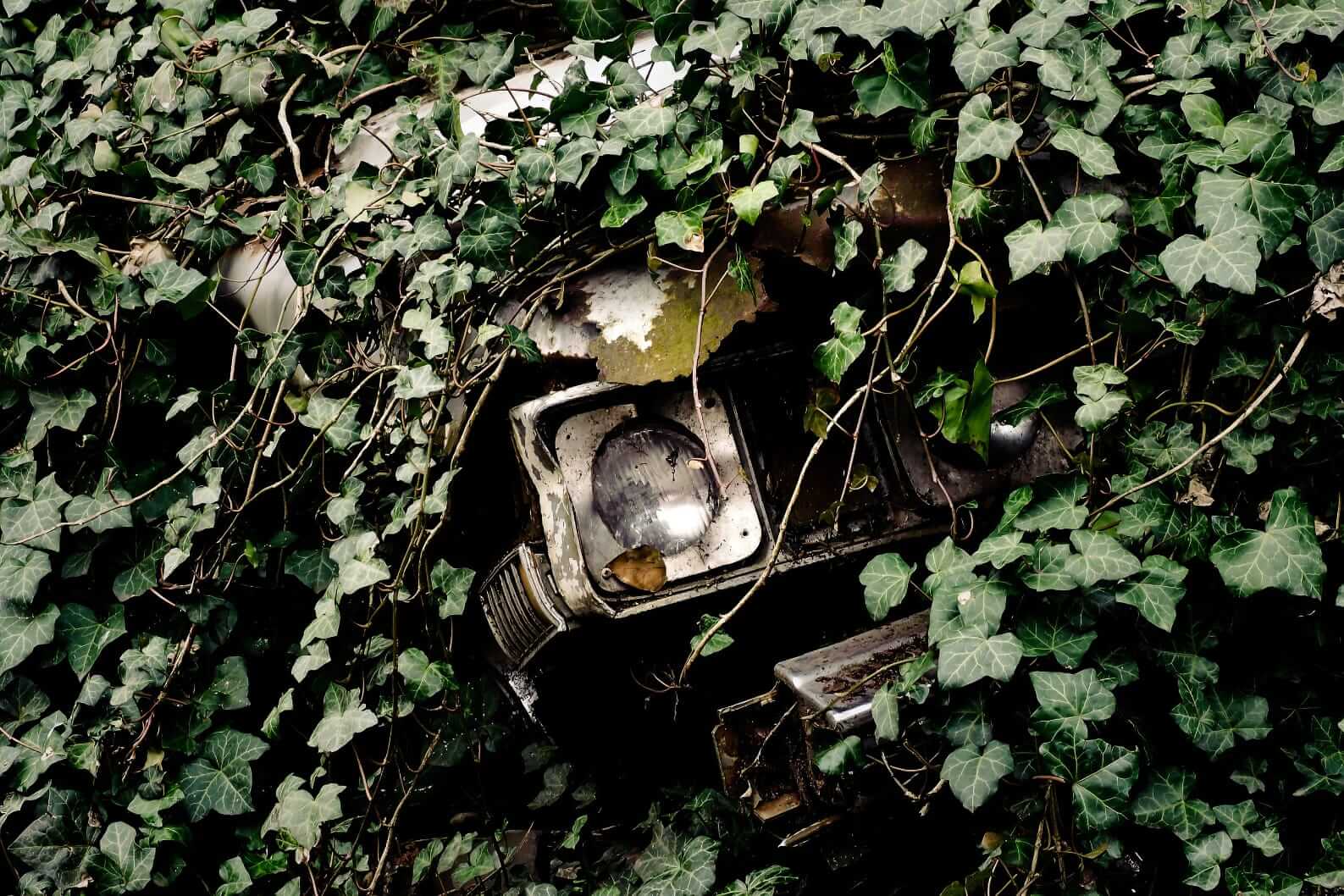Our Green Tangle Museum sits nestled in the valley off Highway 4. It is an open-air concept, there is no building, and the museum’s footprint exists entirely within a mass of Virginia creeper vines. When clouds block the sun the museum is gray-green like a skinned-over bowl of soup. On sunny days the leaves burn neon-bright, edged with dark shadows like flecks of sumi ink. In the fall, the museum turns blood-red. Visitors are asked to refrain from eating the museum’s berries, as they are highly toxic.
We have no admissions desk, and no curators, but our collection is vast and eclectic.
The north wing borders the Kyner Playfield, and features an ever-growing collection of sporting goods. Soccer balls of all colors and patterns, from black-and-white to bright yellow, are suspended in the shelves of our vines. The sun has cracked most of their skins, and the seasons have relieved them of their pressure. Visitors are cautioned to watch their step, as the floor of the north wing is scattered with chipped golfballs and rain-swollen baseballs, split and spilling their strings.
We have two bicycles, one of which hangs from the ceiling of the north wing. It is a modern ten-speed, previously owned by Levi Orenstein and donated to us by Brayden Collins. Mr. Collins was our most generous benefactor of the last year, having donated the Orenstein bicycle, six baseball gloves, two basketballs, three schoolbags, five lunchboxes, one rented clarinet, and the headless body of a possum.
He recently departed to attend a military academy upstate. We thank him for his contributions.
The southeast wing features several exhibits dedicated to the science of time. This is where our second bicycle can be found, chained to a sapling by one Marcie Pittsmouth in 1975, and which now rests six feet off the ground, embedded in the trunk of that same tree. When it rains, visitors are invited to admire the drool of rust that issues from the tree’s lips of wrinkled bark.
The Green Tangle Museum is also excited to announce that approximately three years from now, coinciding with the fiftieth anniversary of Marcie Pittsmouth’s contribution, the bicycle’s front fork bolt will have completely rusted through, and the wheel will fall to the ground. We warn visitors that the timing of this event cannot be precisely predicted, and as such it will not be advertised.
While they wait, attendees may choose to explore the museum’s Dome, so-dubbed at its inauguration in 1988 by Crossbridge High School students Paul Ashby, Lindsay Milligan, and Roger Zarn, whose initials are inscribed in a commemorative tree in the Dome’s west wall. Use of the fire pit is open to all museum guests. But we caution visitors to wear closed toe shoes, and ask them not to disturb the Dome’s immersive diorama of drug paraphernalia and contraceptive materials.
The prize specimen of the Green Tangle Museum is not yet accessible to the public: the body of forty-four-year-old Herbert Selnick, offered to our archives in 1953 by an anonymous donor. The specimen’s exposure to the elements was mitigated by an archival covering of vines, and volunteer fauna served to remove the most perishable matter.
The “Selnick Skeleton” exhibit will treat visitors to a veritable time capsule, from the specimen’s intact ochre suit of polyester gabardine, to its red-and-white nubuck Oxford shoes. Ephemera enthusiasts will appreciate the still-legible dry cleaning ticket in the back pant pocket, as well as the matchbook from the long-defunct Cassman’s Deli in the jacket pocket. Amateur and experienced forensic analysts alike will marvel at the “kerf marks” carefully revealed by our preservation team, made in the lower thoracic and upper lumbar vertebrae with a Schrade Walden Muskrat 2 model folding knife.
The knife itself can be seen in the collection of the Silty Delta Museum, located six miles south, beneath the Route 80 overpass.
We encourage everyone to visit the Green Tangle, Silty Delta, or any of our sister museums worldwide—in forests, near freeways, behind buildings, under porches, or inside your very own home.
We welcome you and your donations any day, at any hour, year-round.
Sign up below and receive a free ebook of my 2021 flash fiction collection illustrated by my talented artist friends!


This was delightful. A fun conceit and I liked the shift to a darker tone near the end.
Thank you so much! I wasn’t sure about how it would hold up, but this is encouraging to hear. And thanks for reading!
I can’t imagine anything good happening if we visit or donate…congrats on a huge award!
Haha, the place does attract a certain profile, it’s true. And thank you so much!